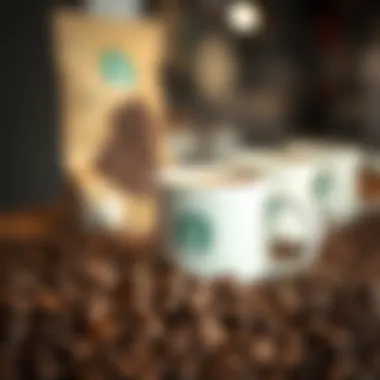Crafting the Perfect DIY Starbucks Latte at Home


Intro
Crafting a latte that rival those from Starbucks right in the comfort of your home can be quite the rewarding endeavor. It’s not just about brewing coffee; it’s about creating an experience. A well-made latte is a blend of rich espresso, velvety milk, and an aromatic touch that makes your taste buds dance. This article serves as your guide to take that leap from casual coffee drinker to latte artisan.
As we unravel the intricacies of this latte-making journey, we will focus on the essential components that transform basic ingredients into a delightful beverage. You might think, "How hard can it be?" But don’t let the simplicity fool you; there’s a world of technique and flavor just waiting to be explored. What makes this process enjoyable is not only the sipping of the final product but also the learning—the direct involvement in selecting the beans, perfecting the milk frothing, and perhaps even experimenting with flavors that tickle your fancy.
So grab your favorite apron and prepare to dive into the art of a DIY Starbucks latte. By the end, you’ll not only have a stellar cup in hand but also a newfound appreciation for the craft behind it.
Understanding the Basics of a Latte
Grasping the fundamentals of a latte is the cornerstone of replicating the café experience at home. This section lays the groundwork for your journey into the world of lattes, emphasizing the significance of understanding essential elements to elevate your coffee game. When you know the basics, you can explore various techniques, perfect your process, and ultimately enjoy a drink that rivals any Starbucks offering.
Defining the Latte
A latte, at its core, is a coffee drink that combines espresso with steamed milk. Originating in Italy, the name ‘latte’ actually translates to ‘milk’, which is quite telling. The simplicity of its definition belies its versatility and appeal. A latte can be as straightforward or intricate as you wish; while many people enjoy plain milk with their espresso, there’s a whole universe of flavors and textures that can be explored.
The beauty of a latte lies in its balance – between the boldness of espresso and the creaminess of milk. Anyone can whip one up, but mastering the art takes practice and an understanding of what goes into it.
Key Ingredients in a Latte
To craft a delightful latte, there are key ingredients you need to keep in mind:
Espresso
Espresso forms the soul of any latte, providing the robust coffee flavor that anchors the entire beverage. Brewed by forcing hot water through finely-ground coffee, espresso is concentrated, rich, and packed with flavor. Its key characteristic is the brewing method that results in a thicker consistency and a unique crema on top.
The popularity of espresso lies in its versatility and strength. It serves as the perfect base for various coffee drinks, including lattes. One of the standout features of espresso is its ability to shine even amidst milk's creaminess, creating that enjoyable contrast in flavor. However, if brewed incorrectly, it can come off as bitter or weak, thus requiring a bit of finesse to master the shot.
Steamed Milk
Steamed milk adds a layer of smoothness and sweetness to your latte, helping to mellow the strong espresso. The process of steaming milk incorporates air to create a velvety mouthfeel, transforming ordinary milk into a sweetened creamy delight.
The key to steamed milk is achieving the right temperature and texture. If it’s too hot, you risk scalding the milk; too cold, and it won't incorporate air properly. A well-steamed milk can elevate your homemade latte to a new level of comfort. When thick and creamy, it can blend seamlessly with espresso, but if done poorly, it can turn watery and bland.
Foamed Milk
Foamed milk contributes to the delightful texture and presentation of a latte. The foam is formed by introducing a significant amount of air during the steaming process, resulting in light, airy bubbles that sit atop the drink.
The lightness of foamed milk makes your latte visually appealing and adds an enjoyable contrast to the weight of espresso. Proper foaming creates microfoam, which is essential for latte art. However, if over-frothed, it can produce dry foam, making it challenging to blend well with the espresso. Understanding how to foam milk properly is vital for anyone hoping to master their latte.
Sugar and Sweeteners
Sugar and sweeteners play a notable role in enhancing the taste of your latte. Each person has their unique palate; thus, the level of sweetness can vary greatly. Some folks may prefer a subtle hint of sugar, while others enjoy a more decadent approach.
Using traditional sugar is always an option, but exploring alternatives like vanilla syrup or agave can add unique flavors. An interesting aspect is finding the balance between sweetness and coffee bitterness, since too much sugar can drown out the coffee's natural richness. On the flip side, opting for no added sweetener can also showcase the drink’s true flavors without any distractions.
In summary, understanding these four critical components will go a long way in your journey of mastering the art of making a latte at home. Combining them harmoniously is key to brewing a satisfying DIY Starbucks-style experience.
Selecting the Right Coffee Beans
When it comes to creating a perfect latte at home, the foundation lies in the coffee beans you select. The type of beans you choose can significantly influence the flavor profile and overall experience of your latte. This section will shed light on the various aspects of coffee beans, emphasizing their role in your DIY home brewing journey.


Types of Coffee Beans
Arabica vs. Robusta
The debate between Arabica and Robusta beans resembles a culinary tug-of-war that isn’t likely to end anytime soon. Arabica is known for its smooth, nuanced flavors, offering a range of taste notes that can include hints of fruit or nuts, while Robusta is often characterized by a bolder and more bitter flavor, with earthy or woody undertones. This distinction plays a crucial role in latte-making, as the subtlety of Arabica can blend nicely with milk, creating a creamy and balanced drink. On the other hand, Robusta typically has a higher caffeine content, which can serve as a pick-me-up for those needing a stronger jolt.
- Key Characteristics of Arabica:
- Key Characteristics of Robusta:
- Smooth flavor profile
- Delicate and often fruity notes
- Lower caffeine content
- Stronger, bolder taste
- Higher caffeine level
- Often cheaper and more robust in production
In summary, choosing Arabica beans can elevate your latte-making game, providing a light, creamy experience where the flavors dance rather than clash. Yet, if you desire an extra kick, considering a blend that includes Robusta can have its perks as well.
Single-Origin vs. Blends
As you delve into coffee bean selection, you might stumble upon the concept of single-origin versus blends. Single-origin beans come from one specific region, which allows drinkers to experience the unique flavors that specific climate and soil conditions impart on the coffee. These beans often carry distinct characteristics that can be both a delight and an adventure for your palate. Conversely, blends combine beans from different regions, aiming to create a consistent flavor profile and texture.
- Unique Features of Single-Origin Beans:
- Unique Features of Blends:
- Reflect the terroir where they are grown
- Ideal for tasting distinct flavor profiles
- Can be a conversation starter for those interested in coffee exploration
- Balanced flavor that appeals to wider audiences
- Consistency in taste across different batches
- Often more accessible price-wise
For this article's goal, considering single-origin beans can amplify the unique experience of crafting a latte. If you're open to experimenting or wish to showcase a specific flavor profile, single-origin might just be your best bet. However, if consistency and familiarity are your guiding lights, a well-crafted blend could serve you well.
Roast Levels and Their Impact
Light Roast
Light roasts can be likened to a crisp morning breeze; they awaken the senses with bright acidity and delicate flavor notes. Typically, these beans retain more of their original, natural flavor characteristics, making them ideal for lattes aimed at showcasing distinct and subtle flavor profiles. The lighter roast generally caters to those who prefer a latte that's surprisingly aromatic and refreshing. However, they can also be a challenge for those who rely on stronger coffee flavors to cut through the milk.
Medium Roast
The medium roast walks a fine line, bringing both brightness and a slightly bolder flavor to the table. This roast level tends to enhance the sweetness of the coffee because certain flavors develop during roasting. For a latte, medium roast can produce a harmonious balance, intertwining nicely with the creaminess of the milk. It is often regarded as a safe bet for those who like their coffee neither too light nor too strong, making it a popular choice for many.
Dark Roast
Dark roasts are often likened to a love-it-or-hate-it dish. These beans undergo a longer roasting period, leading to diminished acidity and more pronounced bitterness. If you're after a latte that packs a punch of flavor, dark roast can deliver that bold experience. It's essential to consider, however, that a strong dark roast could potentially overwhelm the sweetness of the milk rather than meld with it, leaving you with a less balanced beverage.
Brewing the Perfect Espresso
Brewing the perfect espresso is fundamental to crafting a DIY Starbucks latte. If the espresso isn’t right, the rest of the drink won’t follow suit, and it can lead to disappointment. The critical elements include the quality of the equipment, the choice of coffee beans, and the brewing process itself. An espresso shot is concentrated and forms the backbone of your latte, giving it depth and character. A well-extracted espresso will bring out the rich flavors of the coffee, enhancing the entire experience.
Choosing an Espresso Machine
Manual Machines
When considering espresso machines, manual ones are often favored for their hands-on control and authenticity. A significant characteristic of manual machines is that they allow the user to fine-tune every aspect of the brewing process. You can control water temperature, pressure, and extraction time according to your taste. This flexibility makes them a popular choice for coffee enthusiasts who want to experiment.
However, they do require some skill and practice. The unique feature of manual machines lies in their mechanical operation, which allows for a traditional brewing experience. On the downside, they may not be the best fit for someone who prefers convenience, as they demand a bit more effort.


Automatic Machines
Automatic machines, on the other hand, offer a more straightforward approach to brewing. They are designed with user-friendliness in mind, minimizing the guesswork. One key advantage is consistency; an automatic machine can produce the same quality espresso shot every time, which is ideal for beginners or those who can’t spare long moments to brew.
The unique feature is their programmed settings, which can take the temperature, pressure, and timing out of your hands. However, it’s worth noting that some coffee lovers might feel that they sacrifice a certain level of control and personalization in taste that comes with manual brewing.
Grinding Coffee Beans
Grind Size
Choosing the right grind size is crucial for brewing espresso. The grind needs to be fine, often compared to table salt, as this allows for a quick but thorough extraction. If the grind is too coarse, the water passes through too quickly and dilutes the flavor; conversely, if it’s too fine, it can lead to over-extraction and bitterness. For anyone looking to pull a stellar shot, getting this right is vital.
This specific aspect significantly impacts the drink’s final flavor. The unique challenge is finding a balance that works for your specific beans and machine. It can feel like an intricate dance, but once mastered, it optimizes the espresso’s potential.
Freshness Considerations
Another essential element is the freshness of the coffee beans. Beans that are ground just before brewing can make a world of difference in flavor and aroma. Freshly ground coffee provides a richer experience, as the volatile oils and compounds are at their peak just after grinding. Not only does this ensure maximum flavor, but it also helps to create a more vibrant and aromatic espresso.
Focusing on freshness is a beneficial choice for anyone dedicated to crafting their own lattes. However, the unique aspect here is the necessity of proper storage. Whole beans should be kept in an airtight container, away from light, heat, and moisture, to maintain their freshness. It’s a little extra effort, but it pays off in flavor.
Mastering Milk Frothing Techniques
Mastering the frothing of milk is a crucial step in crafting your ideal latte at home. This aspect isn’t just about getting a pretty design; it essentially sets the stage for the whole experience of delighting in your coffee. The right froth can elevate a basic latte to something worth coveting. A properly frothed milk not only adds creaminess but also allows for a balance of flavors, creating that rich and comforting taste people often seek in their favorite Starbucks beverage.
Types of Milk for Frothing
Whole Milk
Whole milk is often seen as the gold standard for frothing due to its high fat content, which leads to creamier and richer froth. The key characteristic here is that the fat in whole milk provides a velvety texture, making the latte luxurious with every sip. Not to mention, it holds its shape well once aerated, giving you that foam suitable for latte art. This makes it a favorite among baristas and home coffee enthusiasts alike.
However, there’s a slight caveat; if you don’t carefully manage the temperature while steaming, you can scald it easily. This could lead to a bitter flavor, which is quite the opposite of what you want. Balancing time and temperature is pivotal when choosing whole milk. But for those who appreciate a full-bodied latte experience, there’s no denying the advantages it brings.
Non-Dairy Alternatives
On the other hand, non-dairy alternatives have surged in popularity, catering to those with lactose intolerance, dietary restrictions, or simply different taste preferences. Options like almond milk, oat milk, and soy milk can provide a unique spin to your latte. Almond milk has a nutty flavor that pairs well with espresso, while oat milk's creamy texture has made it a rising star for frothing.
These alternatives often have a lower fat content compared to whole milk, which can make achieving that frothy texture more challenging. However, many brands like Oatly and Califia Farms have developed specific products designed for baristas, enhancing their frothing capabilities. They might not perfectly mimic the richness of whole milk, but they do allow for a variety of flavors and textures that can make your DIY latte experience exciting. Just remember, the results can vary widely based on the product you choose.
Frothing Equipment
Steam Wand
The steam wand is an integral tool in the frothing process, found in most quality espresso machines. Its beauty lies in its ability to create microfoam, which is essential for that silky latte consistency. The steam reaches high temperatures, enabling you to heat the milk while incorporating air, achieving the desired frothiness.
Why is this tool so popular? Well, for starters, it gives you full control over the frothing process. You can adjust the angle and depth of the wand, which allows for a customized froth consistency. One drawback is that mastering the steam wand can take some practice, as improper technique can lead to overcooked milk or poor texture.
Milk Frother
If a steam wand feels intimidating, a milk frother might be a more user-friendly alternative. These standalone devices are simple and often quite effective in creating froth. They come in various forms, from pumps to electric whisks, and can work with many types of milk.
One significant advantage of using a milk frother is ease of cleaning and operation. They’re generally easier to use for beginners. However, the froth created tends to be a little less consistent compared to that achieved with a steam wand, and you may not get the same velvety texture. Nevertheless, a milk frother is an excellent choice for those just getting the hang of things. It’s all about finding what fits your style.


Frothing Technique Steps
Frothing can feel like an art and a science combined. Here’s a brief run-down of the steps:
- Choose Your Milk: Select a type of milk that suits your taste—whole or a non-dairy alternative.
- Pour the Milk: Fill your pitcher about a third of the way with milk. This allows enough space for froth to expand.
- Position the Wand: Submerge the steam wand just below the surface of the milk and angle it slightly to create a whirlpool effect.
- Turn on the Steam: Start steaming the milk. You should hear a hissing sound but avoid large bubbles.
- Monitor the Temperature: Gradually raise the temperature until it reaches 150°F—no higher than that to avoid scalding.
- Achieve the Froth: Once you notice a nice creamy texture and consistency, turn off the steam.
- Pour and Enjoy: Gently swirl your milk before pouring it into your espresso, creating that beautiful latte.
Milk frothing is all about practice; don’t let an initial hiccup steer you away from the art of creating a delicious latte.
By understanding these techniques and components, you’re one step closer to enjoying a rich, homemade latte that rivals what you might order at Starbucks, all from the comfort of your own kitchen.
Assembling Your DIY Latte
Crafting a DIY latte at home is an art that strikes a delightful balance between the precision of a scientist and the creativity of an artist. The process of assembling your latte is where all those carefully chosen ingredients come together. It’s not just about combining espresso and milk; it's about layering flavors, textures, and an experience that mirrors that loved Starbucks vibe.
Importance of Assembly
This section is crucial for anyone aiming to replicate that café-style essence in the comfort of their own kitchen. It’s like fitting together pieces of a puzzle, each element needing to be in just the right place to create a harmonious drink. The method of assembly can turn a standard latte into a masterpiece. For instance, achieving the right balance between espresso intensity and the creaminess of milk can elevate your home brewing to a professional level.
The beauty of assembling a latte lies not only in its taste but also in its presentation. The act of layering gives you control over the final product, allowing you to adjust based on personal preferences. Whether you like a stronger coffee flavor or a smoother milk base, the way you assemble your drink plays a pivotal role.
Layering Espresso and Milk
When assembling your latte, the order in which you layer your ingredients is paramount. Start with your espresso. Pull your shot (or shots) of espresso directly into your chosen glass or cup. The rich, dark coffee forms the base of your latte and, ideally, you’d want this to be the first layer.
Next comes the steamed milk. Pour the steamed milk over the espresso slowly to preserve the division between the two layers. Some folks swear by the ‘two-thirds milk, one-third espresso’ method. But it’s all about finding that sweet spot that suits your taste. The trick is to keep the milk frothy, adding minimal bubbles while allowing the creamy texture to shine. This can be done by holding back the foam with a spoon while pouring the milk, then spooning some foam on top at the end for that velvety finish.
"A latte is not just a drink; it’s an experience that welcomes you in each sip."
Creating Latte Art
Creating latte art is like the cherry on top, literally and figuratively! It’s the final touch that doesn't just enhance the aesthetics but also the joy of drinking your artistic creation. Proper frothing is the first step to achieving that lovely foam that forms the perfect canvas.
Start by pouring the milk into your cup with a steady hand, keeping it about an inch from the cup’s surface. As you pour, the density of the microfoam will push the espresso upwards, allowing you to create patterns as you tilt into a closer pour. The classic heart or rosette shape can be achieved by adjusting the angle and flow of your pour.
For those with a steady hand and a quick eye, there are plenty of techniques to explore. Some like to practice pouring in circles before drawing lines for that intricate pattern. With practice, what once was a struggle turns into a creative dance of pouring. This technique not only impresses guests but also adds a personal touch to your latte.
Flavor Enhancements and Customizations
Flavor enhancements and customizations play a pivotal role in taking your DIY latte from ordinary to extraordinary. Crafting a personalized drink not only reflects individual taste preferences but also allows you to explore a vast landscape of flavors. This section will explore the various ways you can elevate your latte experience, focusing on syrups, flavorings, spices, and herbs. Let’s delve deeper.
Syrups and Flavorings
When it comes to flavoring your latte, syrups are often the go-to choice. These sweet liquid delights can transform a standard beverage into a delightful treat, resembling the familiar offerings from the Starbucks menu. Depending on your inclinations, you can control the sweetness level and choose various flavors to match your mood.
Common syrup flavors include:
- Vanilla: A classic choice that enhances the overall taste without overwhelming it.
- Caramel: Adds a rich sweetness and depth, perfect for those who enjoy a golden touch.
- Hazelnut: This nutty delight caters to those who appreciate a more complex profile.
- Pumpkin Spice: A seasonal favorite that brings warmth and comfort, especially in cooler months.
Making Your Own Syrups
If you're keen on stretching your culinary arms, making homemade syrups can be both rewarding and fun. Here’s a simple way to whip up your own vanilla syrup:
plaintext
- 1 cup of water
- 1 cup of sugar
- 2 teaspoons of vanilla extract
- Combine water and sugar in a saucepan over medium heat.
- Stir until sugar dissolves completely, then remove from heat.
- Add the vanilla extract and let it cool before storing.







